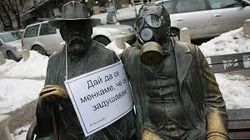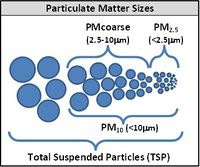ISSS608 2018-19 T1 Assign Stanley Alexander Dion
|
|
|
|
|
|
Problem Overview and Scope
Imagine waking up on a day when the first thing that you sense is a dried throat and the smell of smog! Yeah that happens quite often in Sofia City, the capital of Bulgaria, a city where your haze monitor can easily show you a measurement as worst as 6 times the allowed concentration intake of Air Pollution. Air pollution can take in many forms: starting from gasses, biological molecules, as well as Particulate Matter (PM).
In Sofia city, PM pollutants are not a newly formulated problem. Researchers have been identifying different types of PMs along with its underlying composition and mixtures. Yet the pollution problem has never ceased to exist up until today. Based on size, particulate matter is often divided into two main groups:
- The coarse fraction contains the larger particles with a size ranging from 2.5 to 10 µm (PM10 - PM2.5).
- The fine fraction contains the smaller ones with a size up to 2.5 µm (PM2.5)
- The ultrafine particles in the fine fraction which are smaller than 0.1 µm.
One thing for sure for such small particle, it can go through our nose filter and its irregular shape will cause it stuck deep in the lungs. The bigger the size the more it will stick and cause lungs irritation that will lead to human lungs cancer and death.
The complex composition of the particulate matter can easily divert researchers to come up with the potential insights of the cause and the location of the pollution source. Therefore we put greater emphasis on studying the Spatio-Temporal pattern in PM concentration across Sofia City and to understand the interactions with weather and the city topology that can help us answer the source and potential answer to eliminate the existent pollution.
Objective of Tasks
Task 1
In hope to get the progress of improvement in Sofia City, we would like to characterize the past and most recent situation with respect to air quality measures in Sofia City that will answer the following questions:
- What does a typical day look like for Sofia city? Any trends of possible interest in this investigation?
- What anomalies can we find in the official air quality dataset and how do these affect your analysis of potential problems to the environment?
Task 2
Utilizing a more detailed lookup into the city within the data by Citizen Science community, we would like to know the city one step more detail and answer the following questions:
- Which part of the city shows relatively higher readings than others?
- Are these differences time dependent?
But first, we need to ensure the quality of the observation made by the Science Community. Therefore, we would ensure some of the followings:
- Are the sensors well distributed over the entire city? Are they all working properly at all times?
- Any unexpected behaviours of the sensors by analyzing the readings they capture?
Task 3
Combining all the analysis into view, we need to reveal the relationships between the factors mentioned above and the air quality measure detected the preceeding tasks. Since Urban air pollution is a complex issue, the following line of investigation should be our guidance:
- Interaction with Local energy sources. For example, according to Unmask My City, a global initiative by doctors, nurses, public health practitioners, and allied health professionals dedicated to improving air quality and reducing emissions in our cities, Bulgaria’s main sources of PM10, and fine particle pollution PM2.5 (particles 2.5 microns or smaller) are household burning of fossil fuels or biomass, and transport.
- Interaction with Local meteorology such as temperature, pressure, rainfall, humidity, wind etc
- Interaction with Local topography
- Complex interactions between local topography and meteorological characteristics
- Transboundary pollution, for example, the haze that intruded into Singapore from our neighbours

